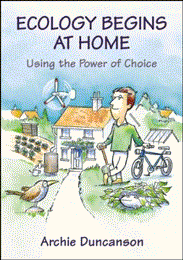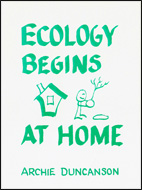|
|
“Generally
speaking, the less you spend, the fewer resources
you use.” “Flying,
unfortunately and sadly, is not really a part of our
healthy, secure and sustainable future.” “Chatting
with friends and loved ones on the internet or on
the phone is not the same as visiting them, but
keeps you in touch as often as you like with
practically no cost in energy, CO2, money or time.” |
|
|
|
Measuring
success If we
are going to successfully reduce our negative impact
on the planet and live a sustainable life, we need
simple ways to measure our consumption and use of
natural resources and see our progress toward
sustainability. Here are a few pointers—Ecology
Begins at Home shows you others. Measuring
resource usage
To
measure progress, you can use the “before and after”
method. For example, I kept track of how many bags of
garbage I threw out each week, made changes in my
living habits, then measured it again and saw what
results I had achieved. I noted how many minutes I
showered each day (hot water usage) and compared week
by week. I kept track of my electricity bills and
compared them from month to month and year to year.
Such measurements gave me satisfaction, and also
showed which changes gave noticeable results and which
didn’t. Eco-Checklists
at the back of Ecology Begins at Home (2008)
can give you a quick overview of your progress as
you fill in and check off actions that you take. You
can put these lists up on your refrigerator door and
modify them to suit your needs. I also kept
an experiment notebook where I jotted
down changes I made, ideas I got and data that I
come across, for example, notes from the newspaper
or seen on Internet. This can be a good place to
save your petrol/gasoline and heating
bills to have them all in one place. I wrote
down the purchase dates, for example, of
dishwashing liquid, washing detergent and other
chemicals and hygienic products, on a list to later
see how long they lasted. I also wrote the purchase
dates directly on the package. Cooking
experiments went in my recipe notebook, with
full details even on things that didn’t turn out so
well (“Sigh, I won’t make that mistake again”). For food,
I got a quick impression by seeing the number of
tins, glass jars and bottled or packaged drinks
on the shelves of my kitchen pantry and in my
refrigerator. Today there aren’t many! I saved my
purchase receipts and added up my total
expenditures for food and household goods.
Factory food is always resource intensive compared
to fresh food, and the price reflects this (not
always so exactly, but generally). Another way to
estimate your food resources is to see how many
bags of recyclable packaging you have each
week (fresh food has almost no packaging, factory
foods leave a trail of packages in addition to all
the resources used at the factory). A car requires
many resources, but gasoline/petrol is
probably the biggest--besides the actual production of
the car itself. Keeping a notebook in the car, you can
jot down petrol expenses and, if you like, for
other car necessities. A simpler method is to just
keep track of how many kilometers/miles you
drive each week, month and year. Heating bills, if
you have them, are a major item to follow. The same
for water bills. Measuring total
footprint
To
measure your total impact at any point in time, you
can look at your total expenses, i.e., how
much money you spend each week, month or year. To be
more accurate, you can leave out big investments such
as a computer or car, or prorate them over the number
of years of their life. Leave out interest and
amortization on loans.
Less consumption of all
kinds means fewer resources and less impact.
Generally speaking, the
less you spend, the fewer resources you use and the
less your impact on the planet’s ecosystems. Footprint
calculators
Instead
of your expenses, you can use a carbon footprint
or ecological footprint calculator on
Internet. These ask you questions about your
lifestyle, then on the basis on your answers,
calculate the CO2 you create annually (your carbon
footprint) or the equivalent land area (your
ecological footprint) that is needed to sustain your
life. These calculators are generally not detailed
enough to help you see changes from day to day, month
to month or even over a year, but like total
expenses, they do show you whether you are
consuming high, average or low in comparison with your
country and with other regions of the world. You can
find links to carbon footprint and ecological
footprint calculators, along with good explanations of
what they measure, at www.wikipedia.org.
Here are a couple of carbon calculators to
try:
www.resurgence.org/resources
http://actonco2.direct.gov.uk. Air travel
impact
Here
are several easy ways to estimate the resources and
impact of your air travel, and by recording them, see
changes from time to time: 1.
You can record flight
hours or air miles for each trip you
take. 2.
You can estimate 1
litre fuel and 6 kg CO2 for every 6
air miles (every 10 kilometres) per passenger.
This fuel is approximately as much as driving a car
the same distance (alone). The CO2 is 3 times the
CO2 of ground transport because high altitude
burning is more potent (according to the IPCC, see
point 4 below). 3.
You can estimate 50
litres fuel and 300 kg CO2 per flight
hour per person. So if you fly 6 hours to a
distant shore, you burn about 6 x 50 x 2 (return trip)
= 4.
You can use an air flight
calculator such as the one at www.chooseclimate.org,
which gives both litres of fuel and kilograms of CO2
for any starting point and destination that you pick
out on a map. Note, however, that this site and many
others use CO2 at its face value of about 2 kg CO2 per
litre fuel rather than its effective impact
that the IPCC in their latest report states is 2-4
times higher. Here I have used an effective impact 3
times higher, or approx. 6 kg CO2 per litre fuel. However
you look at it, air travel is extremely eco-expensive,
and traveling less is an easy way to make giant cuts
in our negative ecosystem impact. Train and bus are
much “cheaper” resource and climate-wise, when you can
take them. Even better and truly eco-smart is chatting
with friends and loved ones on the internet or on the
phone. It’s not the same as visiting them, of course,
but keeps you in touch as often as you like with
practically no cost in energy, CO2, money or time. Both cars and flying will gradually become the
privilege of the super-rich when cheap oil is gone.
Rather than hurrying to use up as much as I can of
these precious but polluting resources before
they’re gone, I prefer to adapt my life now to the
much healthier and safer living standard of a world
without oil spills, oil wars, air pollution and
drastic climate change, to a safer and adequate
standard that can be shared by all. Note: The first printed edition of
Ecology Begins at Home 2008 contains incorrect
figures for air fuel and CO2 per
flight hour (almost twice the values above). Please
use the values above in point 3 or see page 103 in the
2008 pdf
download for the correct text and figures. Copyright
2017 |
|


